高中英语非谓语动词
高中英语-非谓语动词总结
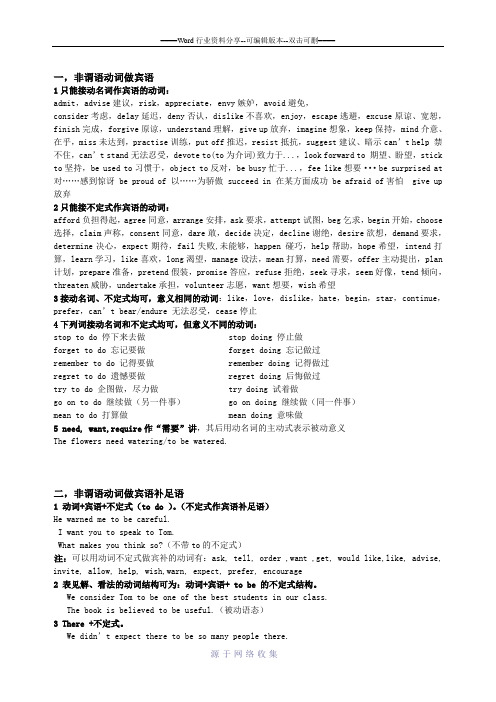
一,非谓语动词做宾语1只能接动名词作宾语的动词:admit,advise建议,risk,appreciate,envy嫉妒,avoid避免,consider考虑,delay延迟,deny否认,dislike不喜欢,enjoy,escape逃避,excuse原谅、宽恕,finish完成,forgive原谅,understand理解,give up放弃,imagine想象,keep保持,mind介意、在乎,miss未达到,practise训练,put off推迟,resist抵抗,suggest建议、暗示can’t help 禁不住,can’t stand无法忍受,devote to(to为介词)致力于...,look forward to 期望、盼望,stick to坚持,be used to习惯于,object to反对,be busy忙于...,fee like想要···be surprised at 对……感到惊讶 be proud of 以……为骄傲 succeed in 在某方面成功 be afraid of害怕 give up 放弃2只能接不定式作宾语的动词:afford负担得起,agree同意,arrange安排,ask要求,attempt试图,beg乞求,begin开始,choose 选择,claim声称,consent同意,dare敢,decide决定,decline谢绝,desire欲想,demand要求,determine决心,expect期待,fail失败,未能够,happen 碰巧,help帮助,hope希望,intend打算,learn学习,like喜欢,long渴望,manage设法,mean打算,need需要,offer主动提出,plan 计划,prepare准备,pretend假装,promise答应,refuse拒绝,seek寻求,seem好像,tend倾向,threaten威胁,undertake承担,volunteer志愿,want想要,wish希望3接动名词、不定式均可,意义相同的动词:like,love,dislike,hate,begin,star,continue,prefer,can’t bear/endure 无法忍受,cease停止4下列词接动名词和不定式均可,但意义不同的动词:stop to do 停下来去做 stop doing 停止做forget to do 忘记要做 forget doing 忘记做过remember to do 记得要做 remember doing 记得做过regret to do 遗憾要做 regret doing 后悔做过try to do 企图做,尽力做 try doing 试着做go on to do 继续做(另一件事) go on doing 继续做(同一件事)mean to do 打算做 mean doing 意味做5 need, want,require作“需要”讲,其后用动名词的主动式表示被动意义The flowers need watering/to be watered.二,非谓语动词做宾语补足语1 动词+宾语+不定式(to do )。
高中英语语法 非谓语动词 全

非谓语动词非谓语动词。
在英语中,不能作句子谓语,而是担任其它语法功能的动词叫做非谓语动词。
非谓语动词的时态和语态的不同形式动词不定式动名词分词主动to do doing doing(同时,主动)被动to be done being done done(被动,完成)进行主动to be doing进行被动being done进行,被动主动完成to havedone having done having done(主动,完成一般作状语)被动完成to havebeen done having beendonehaving beendone(被动,完成一般作状语)非谓语动词在句中的作用主语宾语表语补语定语状语不定式√√√√√√动名词√√√√分词√√√√一:分词(现在分词和过去分词,分别表示:主动,行进&被动,完成)1)作定语The girl standing by the window is my sister.=The girl who is standing by the window is my sister.This is a book written by a famous Chinese writer.= This is a book which was written by a famous Chinese writer.2) 作状语(一般表示时间,原因,条件,伴随)有时可将从句中when/while /unless/if 等保留(While/When)Walking in the street ,I saw her.=While/When I was walking in the street ,I saw her.(表示时间)Seen from the hill,our school looks more beautiful.=When our school is seen from the hill,it looks more beautiful.从小山上看,我们学校更美了。
高中英语语法--非谓语动词

高中英语语法 非谓语动词不定式(to do)1. 非谓语动词 动名词(-ing) 特点2. 双重词性:动词和名词/形容词/现在分词(-ing)副词过去分词(-ed)3. 有时态和语态A 动词不定式一、不定式的意义1. 不定式的一般式:一般式表示的动作或状态发生在谓语动词表示的动作或状态的同时或之后。
当不定式的逻辑主语是这个不定式所表示的动作的承受者时,不定式一般要用被动式(to be done).He seemed to be tired. The building to be finished next month is for our teachers.2. 不定式的进行式:进行式表示动作正在进行,与谓语的动作同时发生。
When I went to his home, he happened to be traveling around the world.3. 不定式的完成式:如果不定式所表示的动作或状态发生在谓语动词所表示动作或状态之前,就用完成式;若是在此基础上的被动含义,就用完成被动式( to have been done).He is said to have written a novel about the Long March.He is said to have been taught French when he was a child.4. 不定式的完成进行式:如果不定式的动作是在谓语所表示的时间之前一直在进行或有可能继续进行的动作,就要用完成进行式.We’re happy to have been working with the experts all the month.二、动词不定式的用法:1. 动词不定式做主语:不定式做主语一般表示具体的某次动作。
而动名词doing 表示习惯的,经常的动作。
1)动词不定式作主语时,谓语用单数。
To do such things is foolish.2)主系表结构。
高中英语语法非谓语动词

European football is played in 80 countries, making it the most famous sports in the world.
过去分词作状语一般表被动或完成 The pop singer, followed by two body guards, came to meet his fans.
3)在want, need, require等动词后,常用动名词的主动形 式表示被动的意思,必须物作主语。例如: My hair needs cutting. (= My hair needs to be cut.)
3.不定式可作独立成分。 to tell the truth / to be honest / to be frank 4.动名词的复合结构 I don’t mind Tom’s/ Tom/his / him opening the window Tom’s /His coming late made his teacher angry.
(进行式) He intended to have told you that.
(完成式主动态) This work of art seemed to have been created long ago. (完成式的被动态) We’re happy to have been working with you.
非谓语动词的形式
动词不定式 一般式 进行式 完成式 完成进行式
现在分词/动名词
主动态 to do to be doing to have done to have been doing 主动态 doing having done done
被动态 to be done to have been done 被动态 being done having been done
高中英语:非谓语动词考点全总结!含义+用法+例题讲解

高中英语:非谓语动词考点全总结!含义+用法+例题讲解,三合一教会你!非谓语动词的含义非谓语动词首先是一种动词形式,其次是这种动词形式不能做谓语,综合这两点,我们将其叫做非谓语动词。
非谓语动词的形式非谓语动词包含四种形式,即不定式、动名词、现在分词和过去分词。
其中,每种形式按照发生时间和主被动又包括不同的子形式。
具体如下:1. 不定式①基本形式:to do(表示主动,并且一般表示将来)②被动式:to be done(表示被动,并且一般表示将来)③进行式:to be doing (表示主动和进行)④完成时:to have done(表示主动和完成)⑤完成被动式:to have been done(表示被动和完成)⑥完成进行式:to have been doing (表示主动和完成进行)The teacher told us to do morning exercises. 老师让我们做早操。
The car to be bought is for his sister.要买的这辆车是给他的姐姐的。
She pretended to be reading when the teacher came into the classroom.老师进来时,她假装正在读书。
The thief is said to have escaped.据说小偷已经逃跑了。
The thief is said to have been arrested.据说小偷已经被抓住了。
She is said to have been working in the factory over the last 20 years.据说在过去的20年里,她一直在这家工厂工作。
2. 动名词①基本形式:doing (表示主动)②被动式:being done(表示被动)③完成式:having done(表示主动和完成)④完成被动式:having been done(表示被动和完成)Travelling in space by ordinary people will be common in the future.在未来,普通人在太空旅行将会是普遍的事情。
高中英语高考复习非谓语动词知识讲解
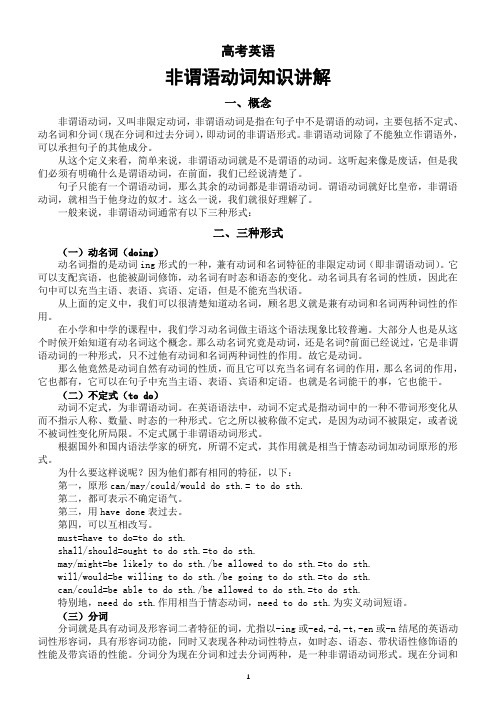
高考英语非谓语动词知识讲解一、概念非谓语动词,又叫非限定动词,非谓语动词是指在句子中不是谓语的动词,主要包括不定式、动名词和分词(现在分词和过去分词),即动词的非谓语形式。
非谓语动词除了不能独立作谓语外,可以承担句子的其他成分。
从这个定义来看,简单来说,非谓语动词就是不是谓语的动词。
这听起来像是废话,但是我们必须有明确什么是谓语动词,在前面,我们已经说清楚了。
句子只能有一个谓语动词,那么其余的动词都是非谓语动词。
谓语动词就好比皇帝,非谓语动词,就相当于他身边的奴才。
这么一说,我们就很好理解了。
一般来说,非谓语动词通常有以下三种形式:二、三种形式(一)动名词(doing)动名词指的是动词ing形式的一种,兼有动词和名词特征的非限定动词(即非谓语动词)。
它可以支配宾语,也能被副词修饰,动名词有时态和语态的变化。
动名词具有名词的性质,因此在句中可以充当主语、表语、宾语、定语,但是不能充当状语。
从上面的定义中,我们可以很清楚知道动名词,顾名思义就是兼有动词和名词两种词性的作用。
在小学和中学的课程中,我们学习动名词做主语这个语法现象比较普遍。
大部分人也是从这个时候开始知道有动名词这个概念。
那么动名词究竟是动词,还是名词?前面已经说过,它是非谓语动词的一种形式,只不过他有动词和名词两种词性的作用。
故它是动词。
那么他竟然是动词自然有动词的性质,而且它可以充当名词有名词的作用,那么名词的作用,它也都有,它可以在句子中充当主语、表语、宾语和定语。
也就是名词能干的事,它也能干。
(二)不定式(to do)动词不定式,为非谓语动词。
在英语语法中,动词不定式是指动词中的一种不带词形变化从而不指示人称、数量、时态的一种形式。
它之所以被称做不定式,是因为动词不被限定,或者说不被词性变化所局限。
不定式属于非谓语动词形式。
根据国外和国内语法学家的研究,所谓不定式,其作用就是相当于情态动词加动词原形的形式。
为什么要这样说呢?因为他们都有相同的特征,以下:第一,原形can/may/could/would do sth.= to do sth.第二,都可表示不确定语气。
高中英语非谓语动词课件(70张)

主语
宾语 表语
定语 状语
I warned the patient not to eat cold water
after the operation.
宾补
(1)作主语 不定式做主语时, 可以直接放在谓语动词之前。
To see is to believe.
Subject+ find/think/feel/make/ consider… it +adj/n + to do sth.
1.We thought ___ better ___ start early. 2.Do you consider ___ better not __ go? 3. I feel __ my duty __ change all that. 4.We think __ important __ obey the law. 5.I know __ impossible __ finish so much homework in a day.
句型3: It is adj. for/of sb. to do sth.
It is + adj + for sb to do sth (是形容事物的性质的 ) It is + adj + of sb to do sth (是形容人的品质的 )
It is easy for me to finish this work before ten. It is a great honor for us to be present at your birthday party.
make let have
do + sb. + doing
高中英语非谓语动词(共32张PPT)

为了避免重复,作为宾语的不定式第二次出现的时候往 往省略只留下不定式符号。
动词: want wish hope hate plan try love you can try that again if you want to.
不定式做形容词的用法 (3)作定语(位于他所修饰的词的后面,并 且放在其他后置定语的后面)
动宾关系:
He always has a lot of meetings to attend. To attend 的逻辑宾语the meeting To attend 是定语 不定式做定语的时候,他所修饰的名词和不定式构成动宾 关系或者主谓关系. 1. 名词或者代词+不定式(to+不及物动词+介词) 如果做定语用的不定式是不及物动词,就要在这个不及物 动词后面加上介词,是被修饰的词成为这个介词的逻辑宾 语
他可以带有自己的主语(为了和句子的真正主语区分开来, : 我们称它为不定式的逻辑主语)
For him to draw such a picture is not easy.(主 语)for him 是不定式的逻辑主语,句子的真正主语是整个不定式短语。
不定式做名词的用法:
动词 不定式是指在动词原形前面带有不定式符号’to”的形式,与介
√
√
√
√
动名词
√
√
√
√
×
×
现在分词
×
×
√
√
√
√
过去分词
高中英语非谓语动词讲解_(整理)
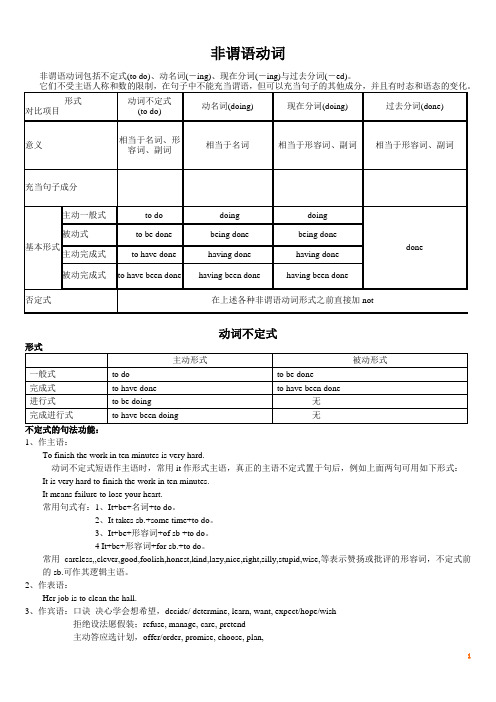
非谓语动词非谓语动词包括不定式(to do)、动名词(-ing)、现在分词(-ing)与过去分词(-ed)。
动词不定式不定式的句法功能:1、作主语:To finish the work in ten minutes is very hard.动词不定式短语作主语时,常用it作形式主语,真正的主语不定式置于句后,例如上面两句可用如下形式:It is very hard to finish the work in ten minutes.It means failure to lose your heart.常用句式有:1、It+be+名词+to do。
2、It takes sb.+some time+to do。
3、It+be+形容词+of sb +to do。
4 It+be+形容词+for sb.+to do。
常用careless,,clever,good,foolish,honest,kind,lazy,nice,right,silly,stupid,wise,等表示赞扬或批评的形容词,不定式前的sb.可作其逻辑主语。
2、作表语:Her job is to clean the hall.3、作宾语:口诀决心学会想希望,decide/ determine, learn, want, expect/hope/wish拒绝设法愿假装;refuse, manage, care, pretend主动答应选计划,offer/order, promise, choose, plan,同意请求帮一帮。
agree, ask/beg, help如果不定式(宾语)后面有宾语补足语,则用it作形式宾语,真正的宾语(不定式)后置,放在宾语补足语后面,例如:Marx found it important to study the situation in Russia.动词不定式也可充当介词宾语,如:I have no choice but to stay here.He did nothing last Sunday but repair his bike.动词不定式前有时可与疑问词连用,如:He gave us some advice on how to learn English.4、作宾语补足语:在复合宾语中,动词不定式可充当宾语补足语,如下动词常跟这种复合宾语:want, wish, ask, tell, order, beg, permit, help, advise, persuade, allow, prepare, cause, force, call on, wait for, invite.此外,介词有时也与这种复合宾语连用,如:With a lot of work to do, he didn't go to the cinema.有些动词如在使役动词make, have, let和感官动词see, watch, notice, observe, feel, hear, listen to, look at等词后接不定式作宾补,不定式不带to,表示做某事的全过程。
高中英语语法非谓语动词讲解

⾼中英语语法⾮谓语动词讲解⾮谓语动词●概述⾮谓语动词,主要指在主句中表⽰⼀个动作但不能充当谓语,⽽是充当其他语法功能的词。
⾮谓语动词没有⼈称和数的变化,但是有语态和时态的变化。
●⾮谓语动词的三种形式⾮谓语动词有三种:动词不定式、动名词和分词。
这三个基本形式的基础上会有⼀些变化:1.动词不定式2.动名词3.分词●动词不定式的⽤法1.动词不定式的否定式not toShe decided not to be late again.2.动词不定式的完成式完成式表⽰的动作或状态发⽣在位于动词表⽰的动作或状态之前。
I am sorry to have kept you waiting.注意若谓语为表⽰“愿望、打算、意图”的动词时,如hope, think, want, plan, expect, mean, intend等,其后可以跟不定式的完成式表⽰“本来想要或打算做某事,⽽实际上未能实现”。
如:We meant to have stopped him from doing such a thing.征,则构成不定式符合结构的介词应为of前⾯常⽤的形容词有:kind, nice, foolish, silly, stupid, rude, cruel, wise, clever, brace, selfish, crazy, good, careful, careless, impolite, right, wrong等。
It is very kind of you to help me.区别It is important for us to learn English well.4.在某些动词后,可⽤it做形式宾语,然后加宾语补⾜语,最后加不定式作真正的并于。
常见的动词有find, think consider, feel, make等。
They find it difficult to repay the money.5.动词+不定式作宾补ask, want, invite, get, force, expect, allow, persuade, order, warn, remind order, cause, permit, forbid, advise, teach等。
非谓语动词讲解高中

非谓语动词讲解高中非谓语动词是指在句子中作动词的用法,而不是表示谓语动作或状态的主要成分。
非谓语动词包括动词不定式、动名词和分词。
在高中英语中,非谓语动词经常用于句子的修饰、独立主语和补语等的结构。
下面将对非谓语动词进行详细的讲解和提供相关的参考内容。
一、动词不定式(infinitive)动词不定式是动词的一种非谓语形式,常用于句子中作主语、表语、宾语、状语和补足语等。
动词不定式的基本形式是“to+ 动词原形”,它具有名词、形容词和副词的特点。
1. 作主语- It's difficult to learn a new language.(学习一门新语言是困难的。
)2. 作宾语- I want to go to the movies.(我想去看电影。
)3. 作表语- Her dream is to become a doctor.(她的梦想是成为一名医生。
)4. 作状语- She studies hard to improve her grades.(她努力学习以提高自己的成绩。
)5. 作补语- He made me laugh.(他让我笑了。
)二、动名词(gerund)动名词是动词的一种非谓语形式,常用于句子中作主语、宾语、表语和状语等。
动名词的基本形式是动词+ing形式,它具有名词的特点,可以在句子中起到名词的作用。
1. 作主语- Swimming is good exercise.(游泳是很好的运动。
)2. 作宾语- I enjoy reading novels.(我喜欢读小说。
)3. 作表语- His favorite activity is playing basketball.(他最喜欢的活动是打篮球。
)4. 作状语- She learned English by watching American movies.(她通过看美国电影学习英语。
)三、分词(participle)分词是动词的一种非谓语形式,常用于句子中作定语、状语和表语等。
高中英语语法非谓语动词详解

高中英语语法非谓语动词详解高中英语语法非谓语动词详解在高级英语语法中,非谓语动词是非常重要的一部分,也是理解和掌握英语语法的关键。
非谓语动词在句子中扮演着重要的角色,可以表达不同的意思和功能。
本文将详细解释非谓语动词的定义、类型和用法,并通过实例进行分析和解释。
一、定义和类型非谓语动词指的是在句子中不作为主要动词的动词形式,它们可以表达动词本身的含义,但没有主语和谓语动词。
非谓语动词包括动词不定式、动名词和分词三种类型。
1、动词不定式:动词不定式是以“to+”动词原形构成的,表示动词的不同形式,如“to do”、“to being”、“to have done”等。
2、动名词:动名词是在动词后加上“-ing”构成的,表示动词的现在分词形式,如“playing”、“swimming”、“jumping”等。
3、分词:分词是动词的过去分词形式,分为现在分词和过去分词两种。
现在分词表示动词的动作正在进行,如“running”、“singing”、“dancing”等;过去分词表示动词的动作已经完成,如“finished”、“eaten”、“read”等。
二、非谓语动词的用法非谓语动词在句子中可以扮演不同的成分,如主语、宾语、状语等。
下面我们通过具体的例子来分析非谓语动词的用法:1、动词不定式:在句子中,动词不定式可以作为主语、宾语和状语等。
例如,“To learn English is important”(学习英语很重要)中,动词不定式“to learn English”作为主语;或者在“I want to go home”(我想回家)中,动词不定式“to go home”作为宾语。
2、动名词:在句子中,动名词可以作为主语、宾语和状语等。
例如,“Playing sports is fun”(做运动很有趣)中,动名词“Playing sports”作为主语;或者在“I enjoy listening to music”(我喜欢听音乐)中,动名词“listening to music”作为宾语。
高中英语非谓语动词知识点

高中英语非谓语动词知识点(经典版)编制人:__________________审核人:__________________审批人:__________________编制单位:__________________编制时间:____年____月____日序言下载提示:该文档是本店铺精心编制而成的,希望大家下载后,能够帮助大家解决实际问题。
文档下载后可定制修改,请根据实际需要进行调整和使用,谢谢!并且,本店铺为大家提供各种类型的经典范文,如演讲稿、总结报告、合同协议、方案大全、工作计划、学习计划、条据书信、致辞讲话、教学资料、作文大全、其他范文等等,想了解不同范文格式和写法,敬请关注!Download tips: This document is carefully compiled by this editor. I hope that after you download it, it can help you solve practical problems. The document can be customized and modified after downloading, please adjust and use it according to actual needs, thank you!In addition, this shop provides you with various types of classic sample essays, such as speech drafts, summary reports, contract agreements, project plans, work plans, study plans, letter letters, speeches, teaching materials, essays, other sample essays, etc. Want to know the format and writing of different sample essays, so stay tuned!高中英语非谓语动词知识点有知识者与无知识者的区别,是前者受了苦会抱怨,会诉苦,后者却讷讷不能言。
高中英语知识点归纳非谓语动词的特殊形式与用法
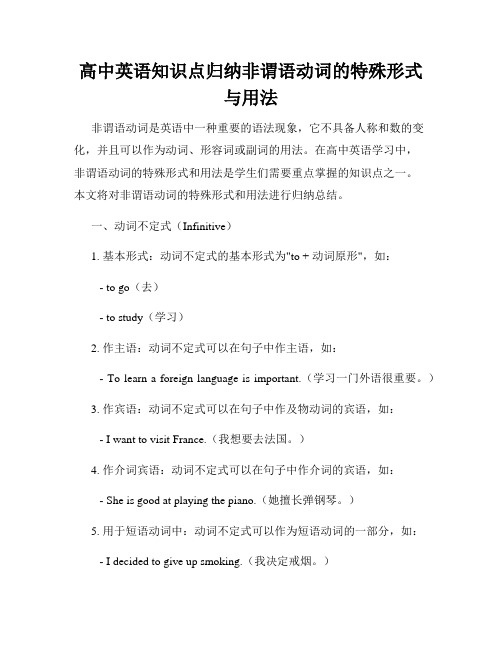
高中英语知识点归纳非谓语动词的特殊形式与用法非谓语动词是英语中一种重要的语法现象,它不具备人称和数的变化,并且可以作为动词、形容词或副词的用法。
在高中英语学习中,非谓语动词的特殊形式和用法是学生们需要重点掌握的知识点之一。
本文将对非谓语动词的特殊形式和用法进行归纳总结。
一、动词不定式(Infinitive)1. 基本形式:动词不定式的基本形式为"to + 动词原形",如:- to go(去)- to study(学习)2. 作主语:动词不定式可以在句子中作主语,如:- To learn a foreign language is important.(学习一门外语很重要。
)3. 作宾语:动词不定式可以在句子中作及物动词的宾语,如:- I want to visit France.(我想要去法国。
)4. 作介词宾语:动词不定式可以在句子中作介词的宾语,如:- She is good at playing the piano.(她擅长弹钢琴。
)5. 用于短语动词中:动词不定式可以作为短语动词的一部分,如:- I decided to give up smoking.(我决定戒烟。
)6. 用于形容词后:动词不定式可以放在形容词后作定语,如:- He is happy to help others.(他乐于助人。
)二、动名词(Gerund)1. 基本形式:动名词的基本形式为动词的现在分词形式(+ing),如:- going(去)- studying(学习)2. 作主语:动名词可以在句子中作主语,如:- Studying English is interesting.(学习英语很有趣。
)3. 作宾语:动名词可以在句子中作及物动词的宾语,如:- I enjoy swimming in the sea.(我喜欢在海里游泳。
)4. 作介词宾语:动名词可以在句子中作介词的宾语,如:- She is interested in playing basketball.(她对打篮球很感兴趣。
高中英语非谓语动词

one’s / N’s + doing / There + being
- His attending the meeting surprised everyone here. - Tom’s winning made us excited. - I’m proud of your performing in the exam. - I don’t mind Tom’s smoking here. 注:复合结构作宾语时可用宾格或普通格代替 - I’m proud of you performing in the exam. - I don’t mind Tom smoking here.
/surprising.
•主语和表语 宾语 一致 eg. Seeing is believing.
=To see is to believe. Saying is one thing but doing is another.
= To say is one thing but to do is another.
emperor in the procession.
A. laugh at C. laughing at
B. to laugh at D. laughing on
二. forget remember regret mean stop try go on 后接 doing 和 to do 含义不同
eg. -I remember seeing him somewhere before.曾做过
How about two of us _C___ a walk down the garden A. to take B. take C. taking D. to be taking
高中英语非谓语动词讲解(共61张PPT)

物动词的话,后应跟着一个相应的介词,但如果被修饰的是 place、time、way 就除外。 如:We must rent a house to live in.
That is a very good place to live.
在学习动词不定式的时候还有两点要注意哦!
1、“一感二听三让四看见”,要用省to的不定 式作宾补,但变为被动句时,要加上to, 如
e.g. 1)We hear him sing in the next room. He is heard to sing in the next room.
(feel, hear, listen to, see, watch, notice , look at, have , make, let)
What ∕ How about doing 做某事怎么样?
此tto doing sth.(盼望) pay attention to doing sth.(注意) be used to doing sth. (习惯于) prefer doing sth to doing sth (宁愿做某事而不愿做某事 ) devote to doing sth (致力于)
牛刀小试
1. My mother often asks me __D___ some cleaning on Sundays
区分下列词组:
see sb. doing/ do sth. hear sb. doing/ do sth. watch sb. doing/ do sth. notice sb. doing/ do sth.
感官动词 see, watch, look at, notice, hear, listen to, feel
高中英语非谓语动词讲解

高中英语非谓语动词讲解非谓语动词包括不定式(to do)、动名词(-ing)、现在分词(-ing)和过去分词(-ed)。
它们不受主语人称和数的限制,不能充当谓语,但可以充当句子的其他成分,并且有时态和语态的变化。
动词不定式没有人称和数的变化,不能独立作谓语,但可以有自己的宾语和状语。
一般式表示的动作或状态发生在谓语动词表示的动作或状态的同时或之后,而进行式表示动作正在进行,与谓语的动作同时发生。
动名词相当于名词,可以作主语、宾语、表语、宾补、定语和状语。
它往往有将来意味,指经常性、惯性的动作或有现在意味。
现在分词和过去分词分别相当于形容词和副词,可以作定语和状语。
现在分词往往有进行意味,而过去分词则表示被动或完成的意义。
在上述各种非谓语动词形式之前直接加not可以构成否定式。
此外,动词不定式还有完成式、进行式和完成进行式,分别表示完成、正在进行和完成正在进行的动作或状态。
被动形式则表示该动作或状态的承受者。
需要注意的是,当不定式的逻辑主语是这个不定式所表示的动作的承受者时,不定式一般要用被动式(to be done)。
例如,The building to be finished next month is for our ___.3.关于不定式的完成式:当不定式所表示的动作或状态发生在谓语动词所表示的动作或状态之前时,使用完成式。
如果带有被动含义,则使用完成被动式(to have been done)。
例如:据说他写了一本关于长征的小说。
他据说在儿时学过法语。
4.关于不定式的完成进行式:如果不定式的动作在谓语所表示的时间之前一直在进行或可能继续进行,则使用完成进行式。
例如:我们很高兴一整个月都在和专家们一起工作。
二、不定式的用法:1.不定式做主语:不定式作主语一般表示具体的某次动作,而动名词doing则表示惯性的、经常性的动作。
具体表现为:1)不定式作主语时,谓语使用单数形式,例如:做这样的事情是愚蠢的。
高中英语语法梳理-非谓语动词
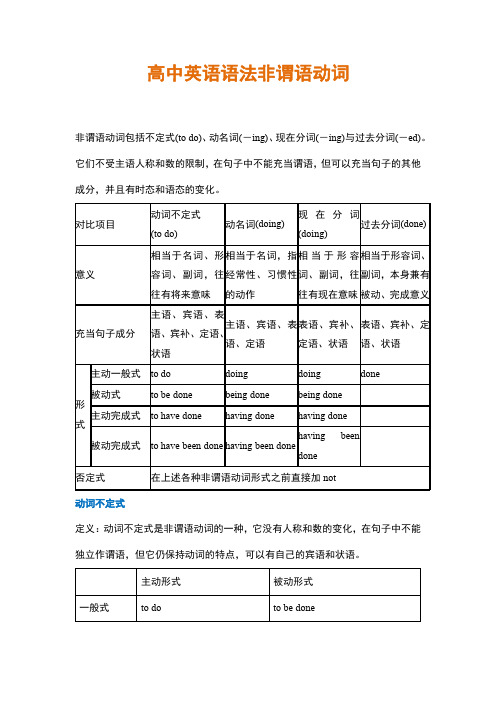
高中英语语法非谓语动词非谓语动词包括不定式(to do)、动名词(-ing)、现在分词(-ing)与过去分词(-ed)。
它们不受主语人称和数的限制,在句子中不能充当谓语,但可以充当句子的其他成分,并且有时态和语态的变化。
动词不定式定义:动词不定式是非谓语动词的一种,它没有人称和数的变化,在句子中不能独立作谓语,但它仍保持动词的特点,可以有自己的宾语和状语。
主动形式被动形式一般式to do to be done一.不定式的意义1.不定式的一般式:一般式表示的动作或状态发生在谓语动词表示的动作或状态的同时或之后。
当不定式的逻辑主语是这个不定式所表示的动作的承受者时,不定式一般要用被动式(to be done).e.g.He seemed to be tired.The building to be finished next month is for our teachers.2.不定式的进行式:进行式表示动作正在进行,与谓语的动作同时发生。
e.g.When I went to his home,he happened to be traveling around the world.3.不定式的完成式:如果不定式所表示的动作或状态发生在谓语动词所表示动作或状态之前,就用完成式;若是在此基础上的被动含义,就用完成被动式(to have been done).e.g.He is said to have written a novel about the Long March.He is said to have been taught French when he was a child.4.不定式的完成进行式:如果不定式的动作是在谓语所表示的时间之前一直在进行或有可能继续进行的动作,就要用完成进行式.e.g.We’re happy to have been working with the experts all the month.二.不定式的用法1.不定式做主语:不定式做主语一般表示具体的某次动作。
高中英语 非谓语动词专题(共20张PPT)

非谓语动词常考点 1. 非谓语动词作定语 2.非谓语动词做状语 3.非谓语动词做宾补 4. with 的复合结构
The teacher sitting there are from other school. Swimming in summer, we can get cool. I want him to see you.
谓语与非谓语的比较练习: 1.He entered the room,____(hold) a book in his hand. 2.He entered the room, and ____(hold) a book in his hand. 3.I politely refused her invitation and ___(walk) away. 4.I politely refused her invitation , ___(walk) away. 5.A boy ___(call) Jack came here today. 6.A boy who ___(call) Jack came here today. 7.We enjoy the movie____(direct) by a famous artist. 8.We enjoy the movie which____(direct) by a famous artist. 9.When I ___(hear) the news, I was excited . 10.When ___(hear) the news, I was excited . 11. Unless I ____(invite),I won’t attend the party. 12. Unless ____(invite),I won’t attend the party.
高中英语非谓语知识点

高中英语非谓语知识点非谓语动词就是在句子中不能单独作谓语的动词,这样的动词没有人称和数的变化。
它包括动词的不定式、V-ing和V-ed三种形式。
非谓语动词具有双重性质,它既有动词性质,又有非动词性质。
下面小编给大家分享一些高中英语非谓语知识,希望能够帮助大家,欢迎阅读!高中英语非谓语知识1动词不定式动词不定式(infinitive)是动词的一种非限定形式,即非谓语动词形式,它有两种形式:一种是“to + 动词原形”构成(to- infinitive);另一种是不带to的不定式,即动词原形(bare- infinitive)。
所有行为动词都有不定式形式,其否定式是在不定式前加not。
动词不定式(或不定式短语)没有人称和数的变化,在句子中不能作谓语。
(一)动词不定式的时态和语态动词不定式有一般式、进行式、完成式、完成进行式四种时态变化形式,一般式和完成式有被动语态变化形式。
1、不定式的时态意义不定式的时态是以句中谓语动词的时间为依据的(1)一般式表示的动作或状态通常发生在谓语动词之后或同时发生。
They made plans to live in Paris. 他们计划住在巴黎。
(to live 发生在 made plans之后)(2)进行式表示其动作正在进行,与谓语动词发生的动作同时进行。
He pretended to be listening to me carefully. 他假装认真地听我讲。
注意:不定式的进行式常同may, might, can, could, must, need, ought to, should, will, would 等情态动词连用,表示“可能、应当或想必”正在进行的动作。
You oughtn’t to be talking so much. 你不应该说这么多。
He might be reading a novel at that time. 那时他可能正在读小说。
- 1、下载文档前请自行甄别文档内容的完整性,平台不提供额外的编辑、内容补充、找答案等附加服务。
- 2、"仅部分预览"的文档,不可在线预览部分如存在完整性等问题,可反馈申请退款(可完整预览的文档不适用该条件!)。
- 3、如文档侵犯您的权益,请联系客服反馈,我们会尽快为您处理(人工客服工作时间:9:00-18:30)。
高中英语非谓语动词用法对比讲解知识要点:一、不定式与动名词做主语:1、动名词做主语往往表示普通的、一般的行为,不定式做主语常表示某次具体的行为。
例如:Collecting information about children’s health is his job. 收集有关儿童健康的信息是他的工作。
It’s necessary to discuss the problem with an experienced teacher. 与一位有经验的老师讨论这个问题是有必要的。
2、常用不定式做主语的句型有:(1)It’s difficult (important, necessary) for sb. to do(2)I t’s kind (good, friendly, polite, careless, rude, cruel, clever, foolish, brave)of sb. to do.3、常用动名词做主语的句型有:It’s no good (use, fun) doing.It’s (a) waste of time one’s doing.It’s worth while doing.二、不定式、动名词、分词做表语:1、不定式做表语常表示谓语动词所表示动作之后发生的动作。
His teaching aim of this class is to train the students’ speaking ability. 他这节课的教学目的是要训练学生说的能力。
2、动名词做表语是对主语内容的解释,这时主语与表语位置可以互换,动名词常用于口语中。
Its full-time job is laying eggs. 它的(指蚁后)的专职工作是产卵。
3、现在分词做表语表示主语的性质与特征;进行时表示正在进行的动作。
The task of this class is practising the idiom s. (现在分词做表语)With the help of the teacher, the students are practising the idioms. (现在进行时)4、常用作表语的现在分词有:interesting, amusi ng, disappointing, missing, puzzling, exciting, inspiring, following等。
现在分词表示进行与主动。
The joke is amusing .这笑话很逗人。
The problem is puzzling. 这个问题令人不解。
5、过去分词作表语表示主语所处的被动状态或完成某动作的状态。
而被动语态表示主语所承受的动作。
The village is surrounded by high mountains.(过去分词做表语)The enemy was surrounded by the Red Arm y.(被动语态)He is well educated.(过去分词做表语)He has been educated in this college for thre e years.(被动语态)常用在句中做表语的过去分词有:used, closed, covered, interested, followed, sat isfied, surrounded, done, lost, decided, pr epared, saved, shut, won, completed, crowded, dressed, wasted, broken, married, unex pected等。
6、注意如下动词的现在分词与过去分词用法不同:interest(使…感兴趣),surprise(使…吃惊),frighten(使…害怕),excite(使…兴奋),tire (使…疲劳),please(使…满意),puzzle(使…迷惑不解),satisfy(使…满意),amuse(使…娱乐),disappoint(使…失望),i nspire(使…欢欣鼓舞),worry(使…忧虑)它们的现在分词常修饰物(有时修饰人),表示主动,过去分词常修饰人,表示被动(包括某人的look、voice等)。
例如:Climbing is tiring. 爬山很累人。
They are very tired. 他们很疲劳After hearing the exciting news, he gave a s peech in an excited voice.三、不定式与动名词做宾语:1、下列动词跟不定式做宾语:want, wish, hope, expect, ask, pretend, care, d ecide, happen, long, offer, refuse, fail, plan, pre pare, order, cause, afford, beg, manage, agree, promise等。
2、在下列动词或动词短语后用动名词做宾语:enjoy, finish, suggest, avoid, excuse, delay, i magine, keep, miss, appreciate, be busy, be worth, feel like, can’t stand, can’t help, think o f, dream of, be fond of, p revent…(from), kee p…from, stop…(from), protect…from, set about, be engaged in, spend…(in), succeed in, be use d to, look forward to, object to, pay attention t o, insist on等。
3、在forget, remember, stop, regret, try, mean 等动词后跟不定式与动名词意义不同,不定式表示谓语动词之后的动作,而动名词表示的动作发生在谓语动词之前,常用一般式doing 代替完成式having done.He forgot to tell me to post the letter.(他忘了叫我发信。
)I shall never forget finding that rare stamp o n an ordinary envelope. 我永远也忘不了在一个普通信封上发现了那枚珍贵的邮票。
Remember to write to us when you get there.到那里,记得给我们写信。
I don’t remember meeting him. 我不记得见过他。
I regret to tell you that I can’t go to your b irth-day party. 我很遗憾告诉你我不能去参加你的生日晚会了。
They regretted agreeing to the plan. 他们后悔同意这个计划。
He tried to pretend to share in the pleasure with his friend. 他尽力假装与朋友分享欢乐。
She tried reading a novel, but that couldn’t make her forget her sorrow. 她试着看看小说,但也不能使她忘记伤心事。
I didn’t mean to hurt you. 我没有企图伤害你。
A friend indeed means helping others for not hing in return. 真正的朋友意指不图回报地帮助别人。
4、动名词作need, want, require, be worth的宾语时,用主动式代替被动式。
The washing-machine needs repairing.(或用:needs to be repaired)这台洗衣机需要修理。
The point wants referring to. 这一点要提到。
This English novel is worth reading. 这本英文小说值得一读。
The situation in Russian required studying.俄国形式需要研究。
四、不定式与分词在句中做宾语补足语:1、以下动词后跟不定式做宾语补足语:ask, tell, beg, allow, want, like, hate, force, inv ite, persuade, advise, order, cause, encourage, w ait for, call on, permit, forbidThe doctor advised him to stay in bed for anot her few days. 医生嘱咐他再卧床休息几天。
We wish him to remain and accept the post.我们希望他留下来接受这个职位。
(注意hope后不跟不定式做宾补。
)2、有些动词后的复合宾语用不带“to“的不定式,这些动词有:see, watch, notice, hear, feel, m ake, let, have等。
例如:We noticed him enter the house. 我们留意到他进了那所房子。
The boss made them work twelve hours a da y. 老板让他们一天干12小时工作。
注意当make、have不做“迫使、让”讲,而做“制造、有”解时,跟带有to的不定式做状语。
Mother made a cake to celebrate his birthda y. 妈妈做了一个蛋糕给他庆贺生日。
He had a meeting to attend. 他有个会要开。
3、下列动词后的复合宾语用分词做宾补:see,watch, notice, observe, hear, feel, make, set, h ave, leave, keep, find等。
用现在分词还是用过去分词做宾补,要看分词与宾语的关系。
例:We heard him singing the song when we came in. 当我们进来的时候,听见他正唱那首歌。
We have heard the song sung twice. 我们听过这首歌唱过两遍了。
五、非谓语动词做定语:1、不定式做定语放在所修饰的名词后,表示在谓语动词之后发生的动作或过去的某一特定动作。
